Flexural Response of Degraded Polyurethane Foam Core Sandwich Beam with Initial Crack between Facesheet and Core
Abstract
1. Introduction
2. Materials and Methods
3. Experimental Setup
4. Results and Discussion
4.1. Effect of PU Foam Core Thickness
4.2. Effect Displacement Rate of Loading Pin
4.3. Effect of Placing the Initial Interfacial Crack under the Compressive and Tensile Stress Region.
5. Conclusions
Author Contributions
Funding
Conflicts of Interest
References
- Zenkert, D. An Introduction to Sandwich Construction; Engineering Materials Advisory Service: London, UK, 1995. [Google Scholar]
- Vinson, J.R. The Behavior of Sandwich Structures of Isotropic and Composite Materials; CRC Press: Boca Raton, FL, USA, 1999. [Google Scholar]
- Allen, H.G. Analysis and Design of Structural Sandwich Panels: The Commonwealth and International Library: Structures and Solid Body Mechanics Division; Pergamon Press: New York, NY, USA, 2013. [Google Scholar]
- Petras, A.; Sutcliffe, M.P.F. Indentation failure analysis of sandwich beams. Compos. Struct. 2000, 50, 311–318. [Google Scholar] [CrossRef]
- Sandwich Composites. Available online: http://www.angelfire.com/ma/ameyavaidya/F_sandwch3.htm (accessed on 26 November 2020).
- Aviles, F.; Carlsson, L.A. Experimental Study of Debonded Sandwich Panels under Compressive Loading. J. Sandw. Struct. Mater. 2006, 8, 7–31. [Google Scholar] [CrossRef]
- Guedra-Degeorges, D.; Thevenet, P.; Maison, S. Damage Tolerance of Aeronautical Sandwich Structures. In Mechanics of Sandwich Structures; Springer Science and Business Media LLC: Dordrecht, The Netherlands, 1998; pp. 29–36. [Google Scholar]
- Shipsha, A.; Hallström, S.; Zenkert, D. Failure mechanisms and modelling of impact damage in sandwich beams-A 2D approach: Part II-Analysis and Modelling. J. Sandw. Struct. Mater. 2003, 5, 33–51. [Google Scholar] [CrossRef]
- Avilés, F.; A Carlsson, L. Elastic foundation analysis of local face buckling in debonded sandwich columns. Mech. Mater. 2005, 37, 1026–1034. [Google Scholar] [CrossRef]
- Vadakke, V.; Carlsson, L.A. Experimental investigation of compression failure of sandwich specimens with face/core debond. Compos. Part B: Eng. 2004, 35, 583–590. [Google Scholar] [CrossRef]
- Veedu, V.P.; Carlsson, L.A. Finite-element buckling analysis of sandwich columns containing a face/core debond. Compos. Struct. 2005, 69, 143–148. [Google Scholar] [CrossRef]
- Sleight, D.W.; Wang, J.T. Buckling Analysis of Debonded Sandwich Panel Under Compression; NASA Technical Memorandum 4701; NASA: Hampton, VA, USA, 1995. [Google Scholar]
- Vadakke, V.; Carlsson, L.A. Experimental Investigation of Compression Failure Mechanisms of Composite Faced Foam Core Sandwich Specimens. J. Sandw. Struct. Mater. 2004, 6, 327–342. [Google Scholar] [CrossRef]
- Newaz, G.; Dhaliwal, G.S.; Phadatare, A.; Hailat, M. Effect of padding on flexural response of sandwich composites. J. Sandw. Struct. Mater. 2019, 1099636219852005. [Google Scholar] [CrossRef]
- Dhaliwal, G.S.; Newaz, G.M. Experimental and Numerical Investigation of Impact Characteristics of the E-Glass/Toughened Vinylester Composite Car Hood Panels. J. Dyn. Behav. Mater. 2016, 2, 484–499. [Google Scholar] [CrossRef]
- Moslemian, R.; Berggreen, C.; Carlsson, L.; Aviles, F. Failure investigation of debonded sandwich columns: An experimental and numerical study. J. Mech. Mater. Struct. 2009, 4, 1469–1487. [Google Scholar] [CrossRef]
- Sankar, B.; Narayanan, M. Finite Element Analysis of Debonded Sandwich Beams Under Axial Compression. J. Sandw. Struct. Mater. 2001, 3, 197–219. [Google Scholar] [CrossRef]
- Aviles, F.; Carlsson, L.A. Three-dimensional Finite Element Buckling Analysis of Debonded Sandwich Panels. J. Compos. Mater. 2005, 40, 993–1008. [Google Scholar] [CrossRef]
- Sayyidmousavi, A.; Malekzadeh, K.; Bougharara, H. Finite element buckling analysis of laminated composite sandwich panels with transversely flexible core containing a face/core debond. J. Compos. Mater. 2011, 46, 193–202. [Google Scholar] [CrossRef]
- Moslemian, R.; Quispitupa, A.; Berggreen, C.; Hayman, B. Failure of uniformly compression loaded debond damaged sandwich panels — An experimental and numerical study. J. Sandw. Struct. Mater. 2012, 14, 297–324. [Google Scholar] [CrossRef]
- Thomson, R.; Khan, M.; Mouritz, A. Shear properties of a sandwich composite containing defects. Compos. Struct. 1998, 42, 107–118. [Google Scholar] [CrossRef]
- Avilés, F.; A Carlsson, L. Post-buckling and debond propagation in sandwich panels subject to in-plane compression. Eng. Fract. Mech. 2007, 74, 794–806. [Google Scholar] [CrossRef]
- Chen, H.; Bai, R. Postbuckling behavior of face/core debonded composite sandwich plate considering matrix crack and contact effect. Compos. Struct. 2002, 57, 305–313. [Google Scholar] [CrossRef]
- Avery, J.L.; Sankar, B.V. Compressive failure of sandwich beams with debonded face-sheets. J. Compos. Mater. 2000, 34, 1176–1199. [Google Scholar] [CrossRef]
- Jolma, P.; Segercrantz, S.; Berggreen, C. Ultimate Failure of Debond Damaged Sandwich Panels Loaded with Lateral Pressure—An Experimental and Fracture Mechanics Study. J. Sandw. Struct. Mater. 2007, 9, 167–196. [Google Scholar] [CrossRef]
- Nøkkentved, A.; Lundsgaard-Larsen, C.; Berggreen, C. Non-uniform compressive strength of debonded sandwich panels—I. Experimental investigation. J. Sandw. Struct. Mater. 2005, 7, 461–482. [Google Scholar]
- Berggreen, C.; Simonsen, B.C. Non-uniform Compressive Strength of Debonded Sandwich Panels—II. Fracture Mechanics Investigation. J. Sandw. Struct. Mater. 2005, 7, 483–517. [Google Scholar] [CrossRef]
- Berggreen, C. Damage Tolerance of Debonded Sandwich Structures. Ph.D. Thesis, Technical University of Denmark, Kongens Lyngby, Denmark, 2005. [Google Scholar]
- Bull, P.H.; Hallstrom, S. Curved Sandwich Beams with Face–Core Debond Subjected to Bending Moment. J. Sandw. Struct. Mater. 2004, 6, 115–127. [Google Scholar] [CrossRef]
- Niu, K.; Talreja, R. Buckling of a Thin Face Layer on Winkler Foundation with Debonds. J. Sandw. Struct. Mater. 1999, 1, 259–278. [Google Scholar] [CrossRef]
- Lindström, A.; Hallström, S. In-plane compression of sandwich panels with debonds. Compos. Struct. 2010, 92, 532–540. [Google Scholar] [CrossRef]
- Karaeva, A.R.; Kazennov, N.V.; Mordkovich, V.Z.; Urvanov, S.A.; Zhukova, E.A. Carbon Fiber-Reinforced Polyurethane Composites with Modified Carbon–Polymer Interface; Springer Science and Business Media LLC: Cham, Switzerland, 2017; pp. 415–420. [Google Scholar]
- Jiang, S.; Li, Q.; Zhao, Y.; Wang, J.; Kang, M. Effect of surface silanization of carbon fiber on mechanical properties of carbon fiber reinforced polyurethane composites. Compos. Sci. Technol. 2015, 110, 87–94. [Google Scholar] [CrossRef]
- Zhang, Y.; Zhang, Y.; Liu, Y.; Wang, X.; Yang, B. A novel surface modification of carbon fiber for high-performance thermoplastic polyurethane composites. Appl. Surf. Sci. 2016, 382, 144–154. [Google Scholar] [CrossRef]
- Sánchez-Adsuar, M.S.; Linares-Solano, A.; Cazorla-Amorós, D.; Ibarra-Rueda, L. Influence of the nature and the content of carbon fiber on properties of thermoplastic polyurethane-carbon fiber composites. J. Appl. Polym. Sci. 2003, 90, 2676–2683. [Google Scholar] [CrossRef]
- Hong, B.; Xian, G. Ageing of a thermosetting polyurethane and its pultruded carbon fiber plates subjected to seawater immersion. Constr. Build. Mater. 2018, 165, 514–522. [Google Scholar] [CrossRef]
- Alessi, S.; Pitarresi, G.; Spadaro, G. Effect of hydrothermal ageing on the thermal and delamination fracture behaviour of CFRP composites. Compos. Part B: Eng. 2014, 67, 145–153. [Google Scholar] [CrossRef]
- Li, H.; Wang, Z.; Yu, Z.; Sun, M.; Liu, Y. The Low Velocity Impact Response of Foam Core Sandwich Panels with a Shape Memory Alloy Hybrid Face-Sheet. Materials 2018, 11, 2076. [Google Scholar] [CrossRef]
- Liang, M.; Li, X.; Lin, Y.; Zhang, K.; Lu, F. Theoretical Analysis of Blast Protection of Graded Metal Foam-Cored Sandwich Cylinders/Rings. Materials 2020, 13, 3903. [Google Scholar] [CrossRef] [PubMed]
- Zhu, X.; Xiong, C.; Yin, J.; Yin, D.; Deng, H. Bending Experiment and Mechanical Properties Analysis of Composite Sandwich Laminated Box Beams. Materials 2019, 12, 2959. [Google Scholar] [CrossRef] [PubMed]
- Hao, J.; Wu, X.; Oporto, G.S.; Wang, J.; Dahle, G.; Nan, N. Deformation and Failure Behavior of Wooden Sandwich Composites with Taiji Honeycomb Core under a Three-Point Bending Test. Materials 2018, 11, 2325. [Google Scholar] [CrossRef] [PubMed]
- Frostig, Y.; Thomsen, O.T. Non-linear behavior of delaminated unidirectional sandwich panels with partial contact and a transversely flexible core. Int. J. Non-linear Mech. 2005, 40, 633–651. [Google Scholar] [CrossRef]
- Mansourinik, M.; Taheri-Behrooz, F. The effect of interface debonding on flexural behaviour of composite sandwich beams. J. Sandw. Struct. Mater. 2018, 22, 1132–1156. [Google Scholar] [CrossRef]
- Standard A. ASTM D3039/DM Standard Test Method for Tensile Properties of Polymer Matrix Composite Materials; ASTM: Philadelphia, PA, USA, 2008; No. 3039(2008).
- Standard A. ASTM D3410. Standard Test Method for Compressive Properties of Unidirectional or Croesply Fiber Resin Composite; ASTM: Philadelphia, PA, USA, 1990.
- Standard A. ASTM D5379. Standard Test Method for Shear Properties of Composite Materials by the V-notched Beam Method; ASTM: Philadelphia, PA, USA, 1993.
- Standard A. ASTM D1623-09.(2009). Standard Test Method for Tensile and Tensile Adhesion Properties of Rigid Cellular Plastics; ASTM: West Conshohocken, PA, USA, 2015; No. 402.
- Standard A. ASTM D1621-10, 1959 (2010) Standard Test Method for Compressive Properties of Rigid Cellular Plastics; ASTM: West Conshohocken, PA, USA, 2010.
- Standard A. ASTM C273-94. Standard Test Method for Shear Properties of Sandwich Core Materials; ASTM: Philadelphia, PA, USA, 1994.
- ASTM C. 393, Standard Test. Method for Flexural Properties of Sandwich Constructions; American Society for Testing and Materials Annual Book of ASTM Standards: West Conshohocken, PA, USA, 2000.
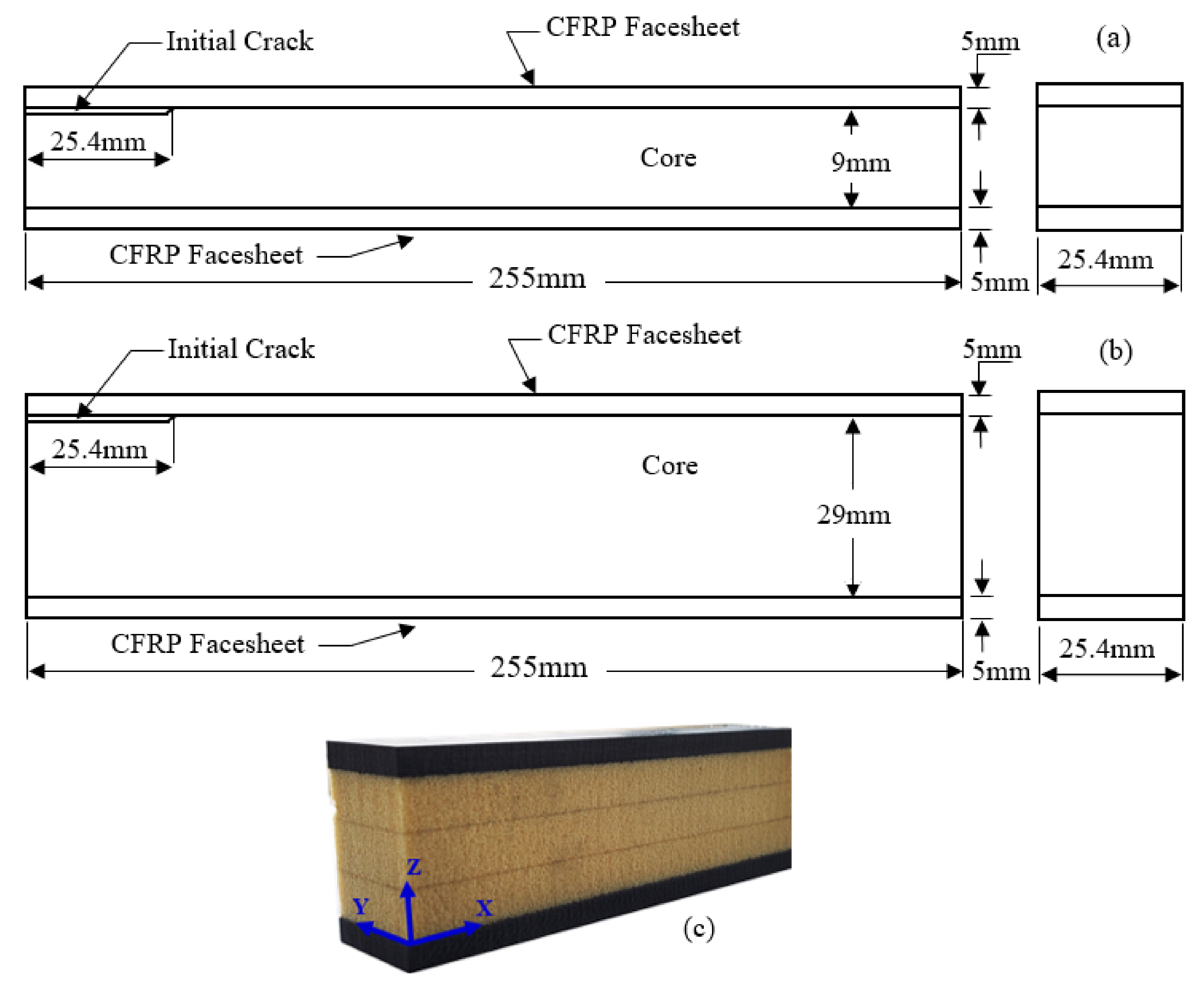
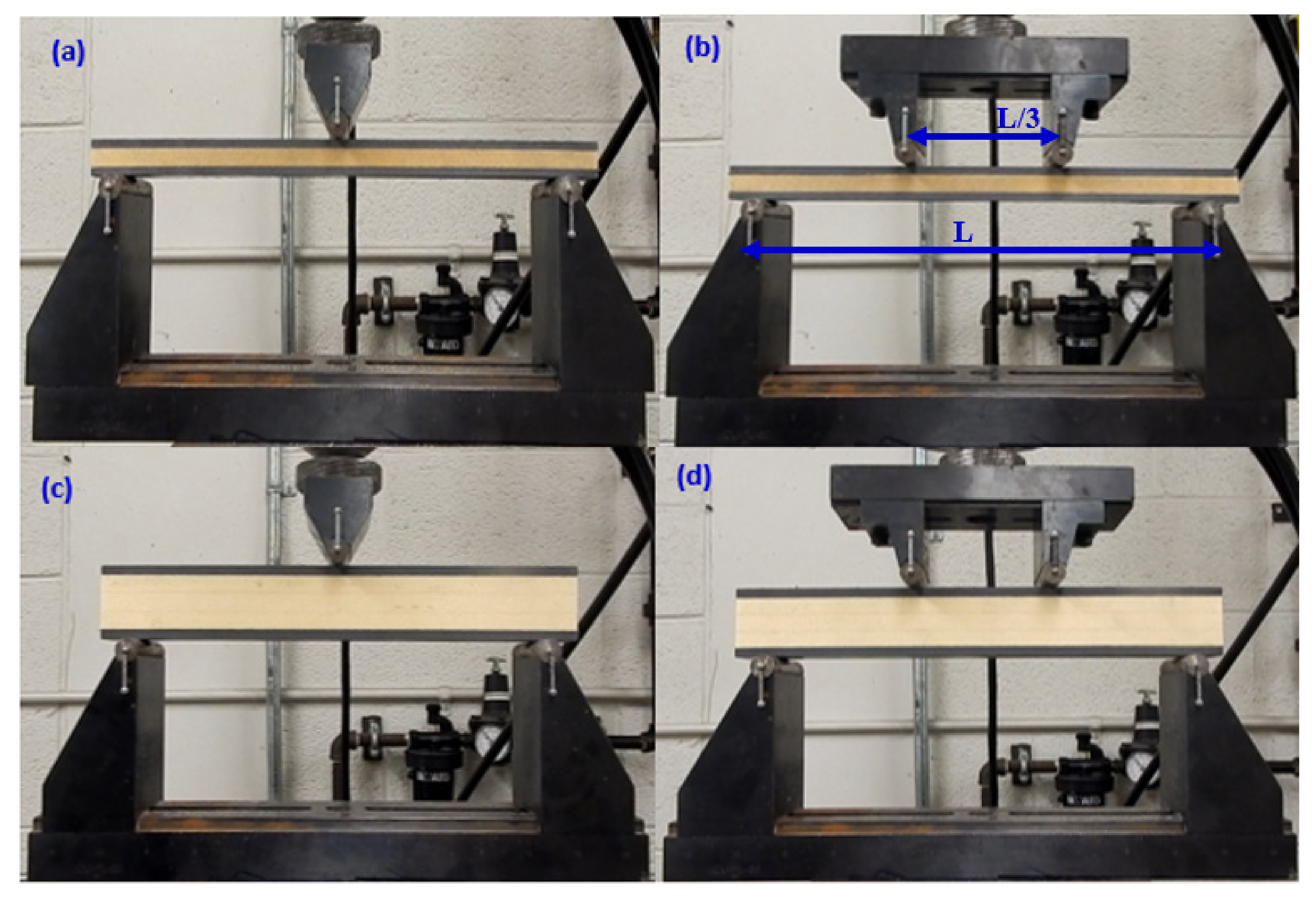
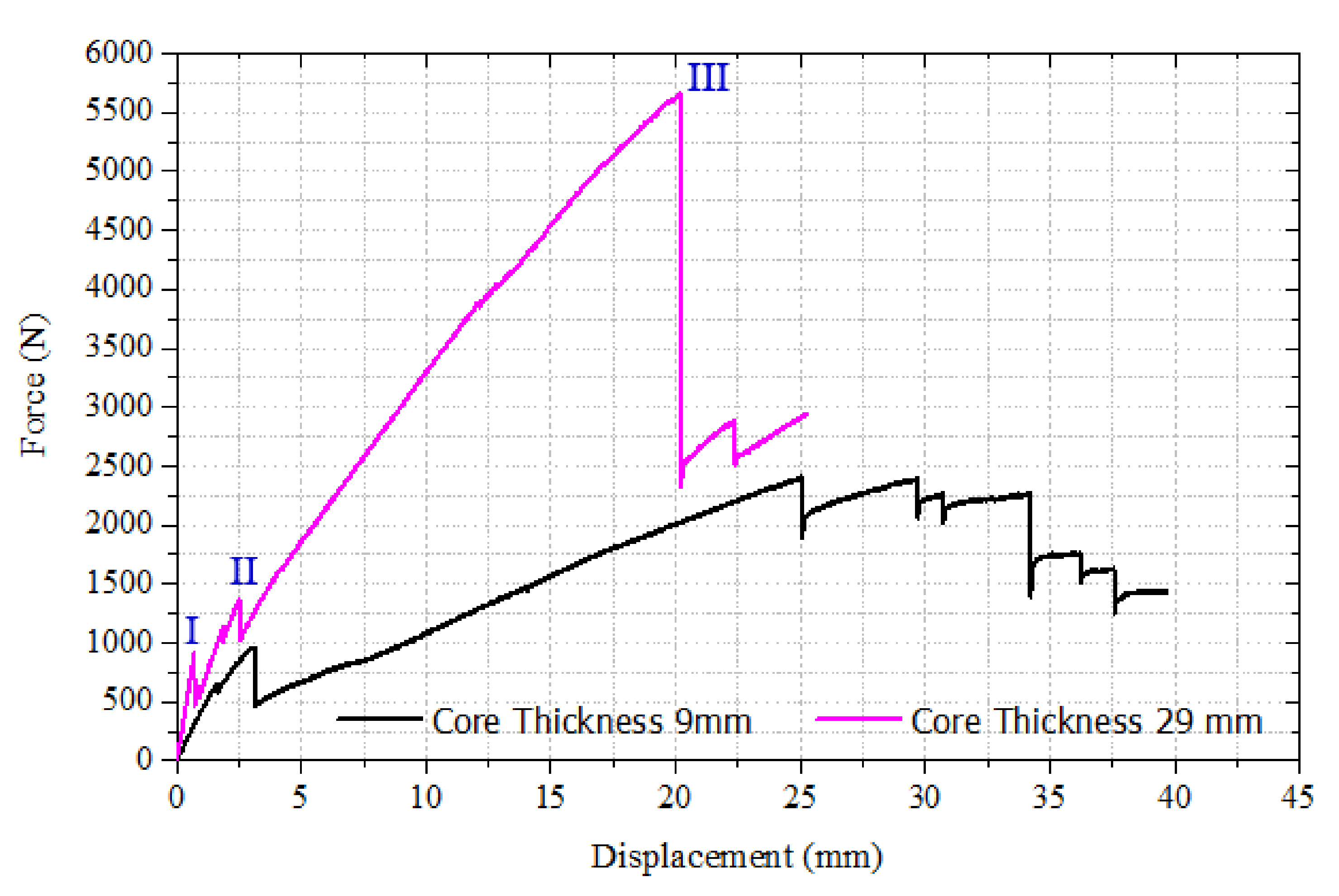
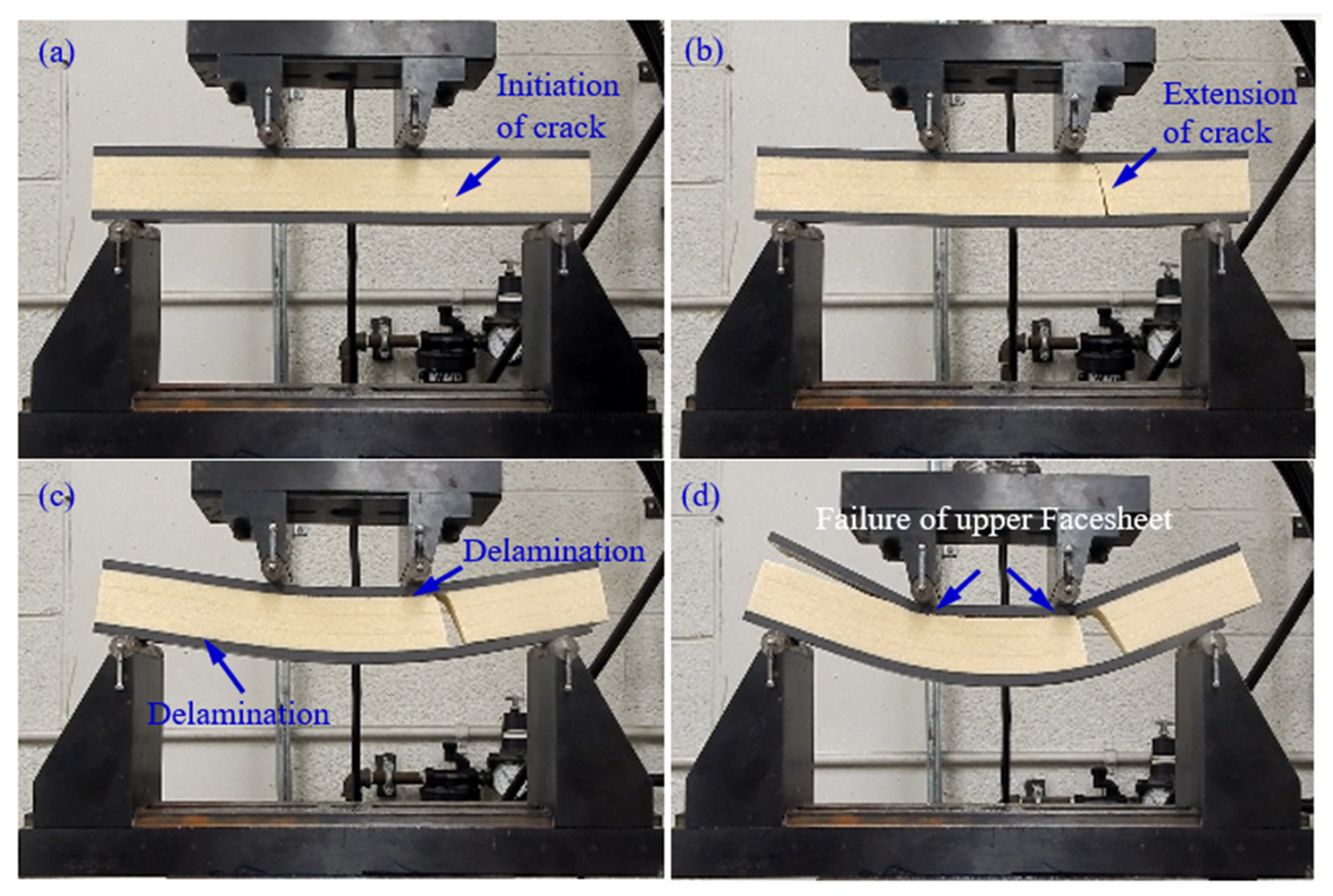
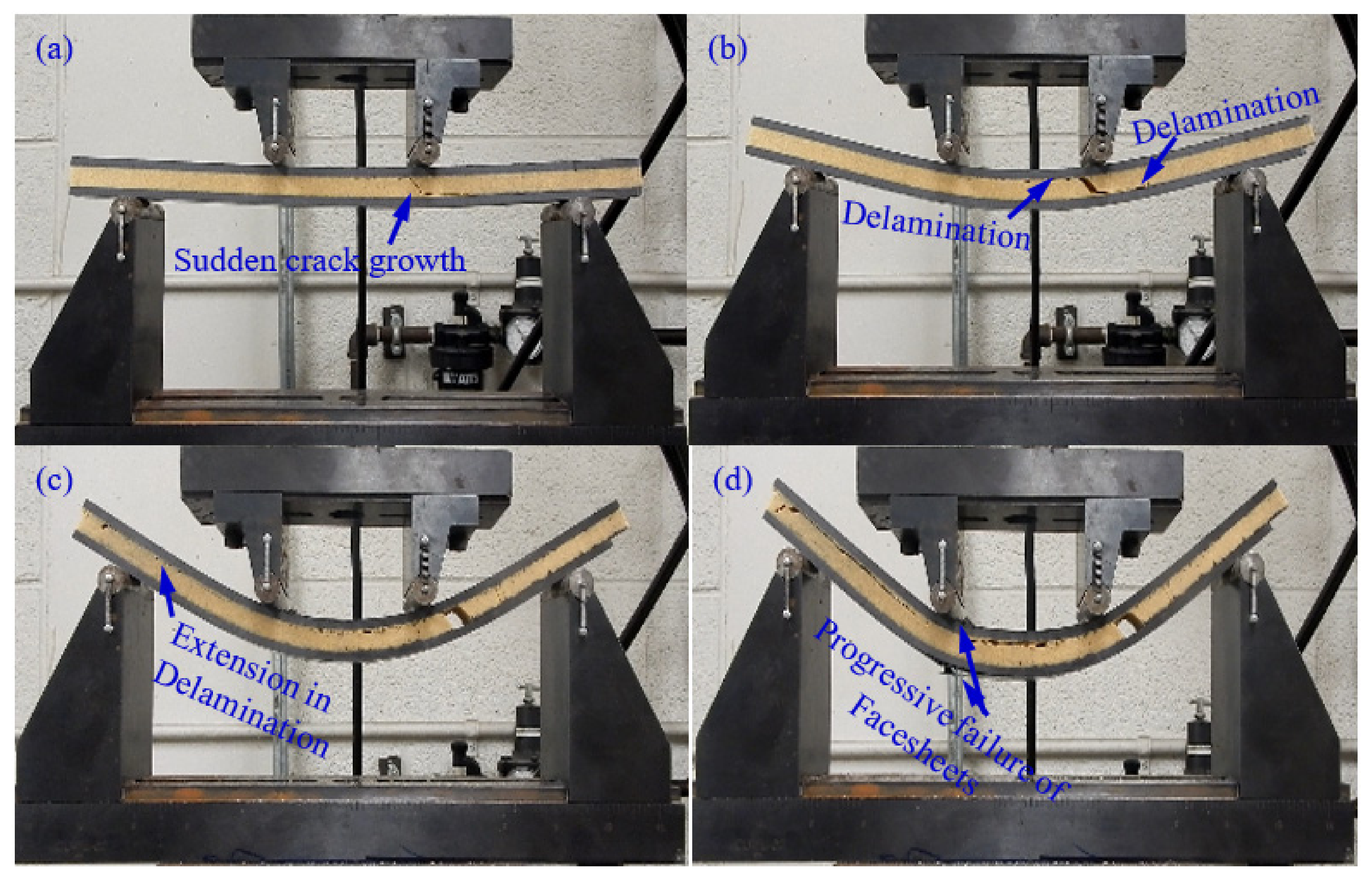
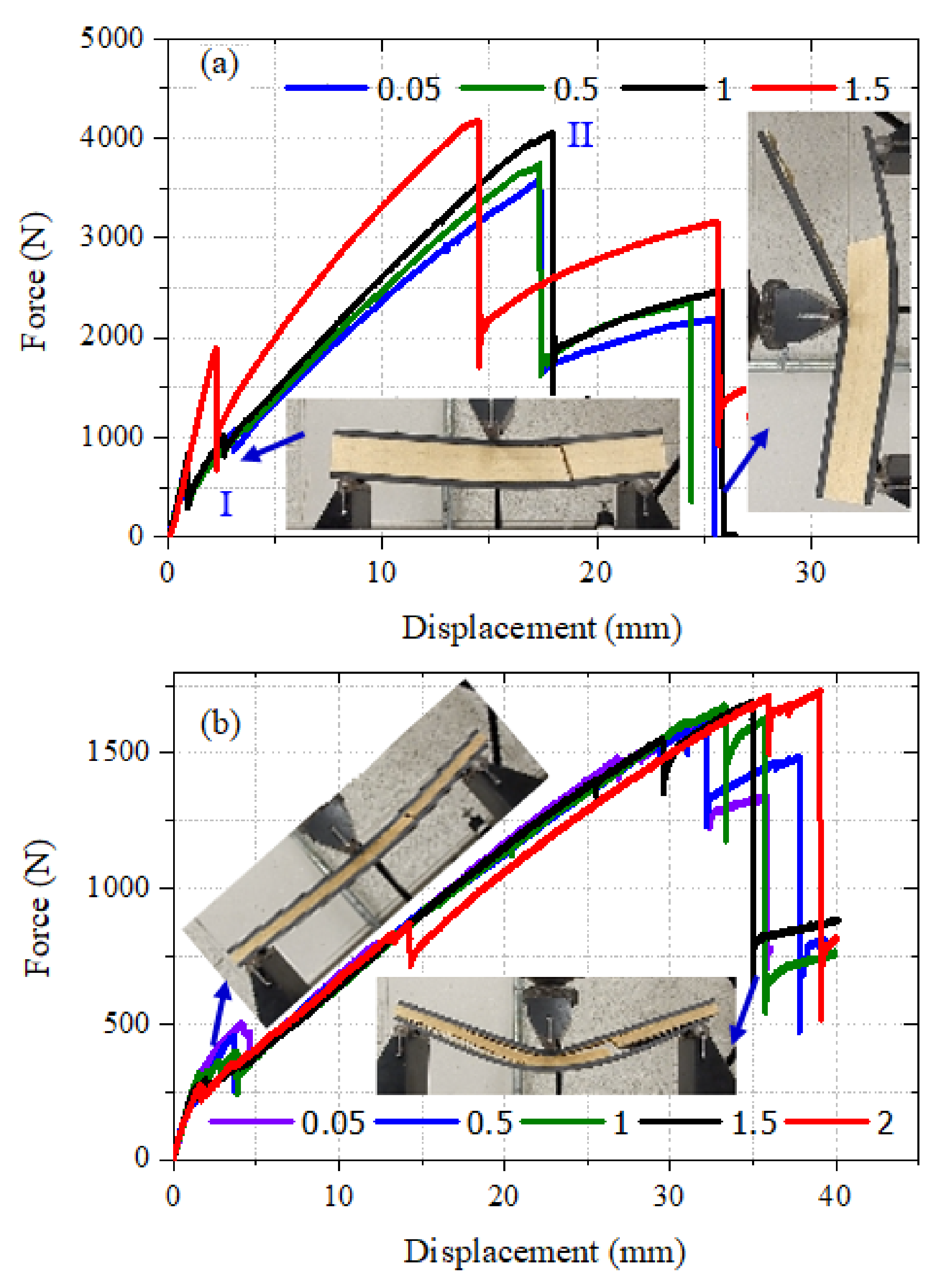
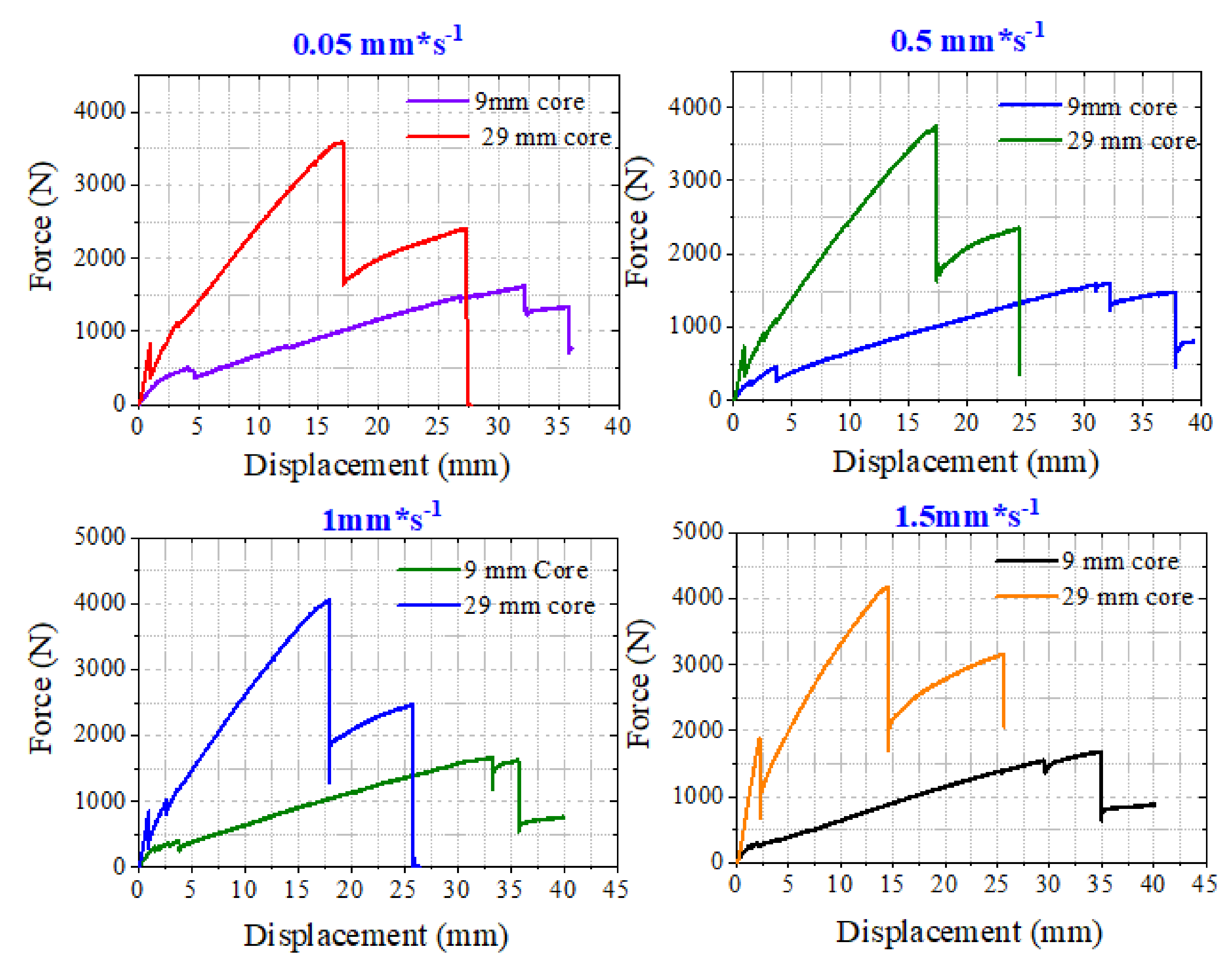
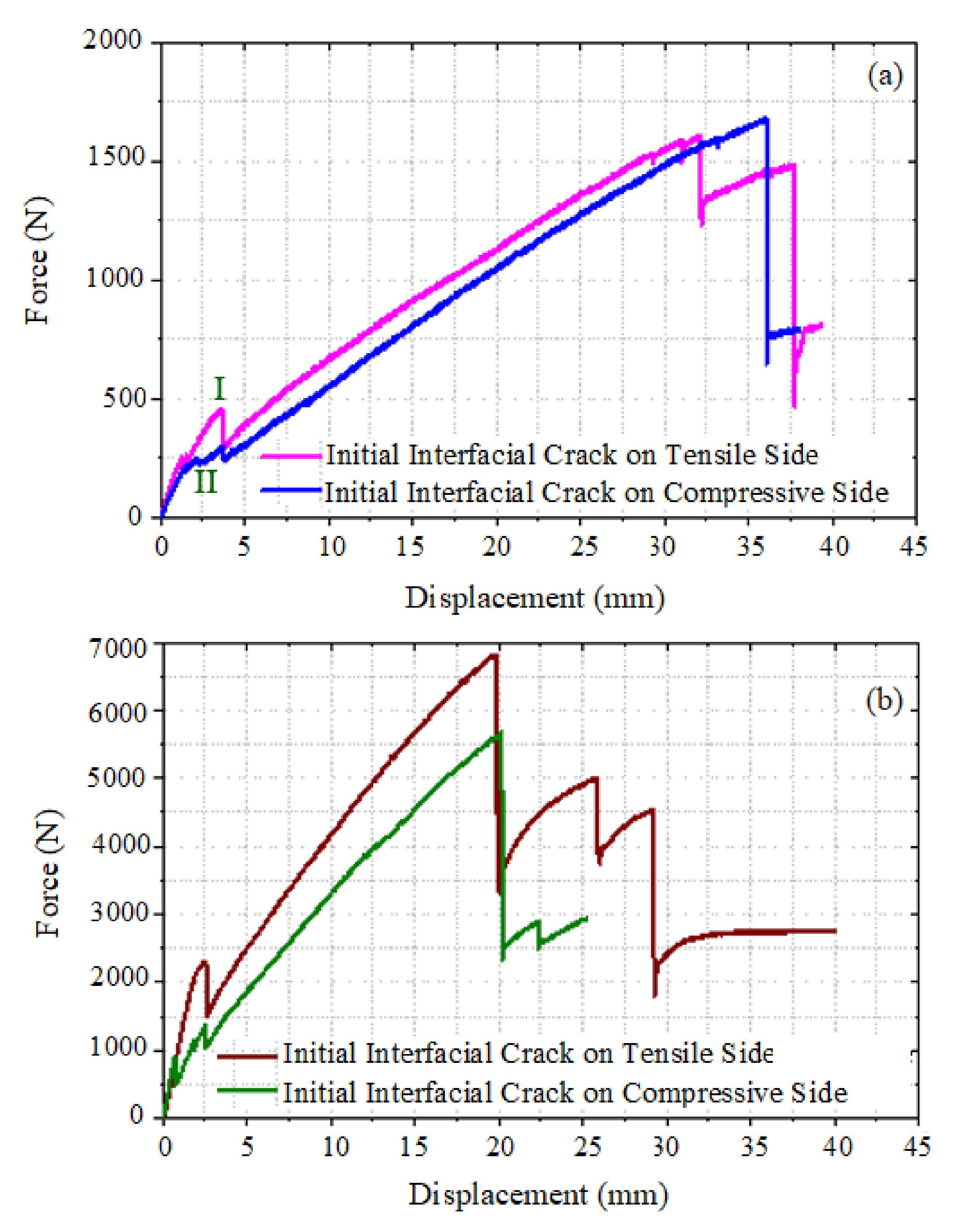
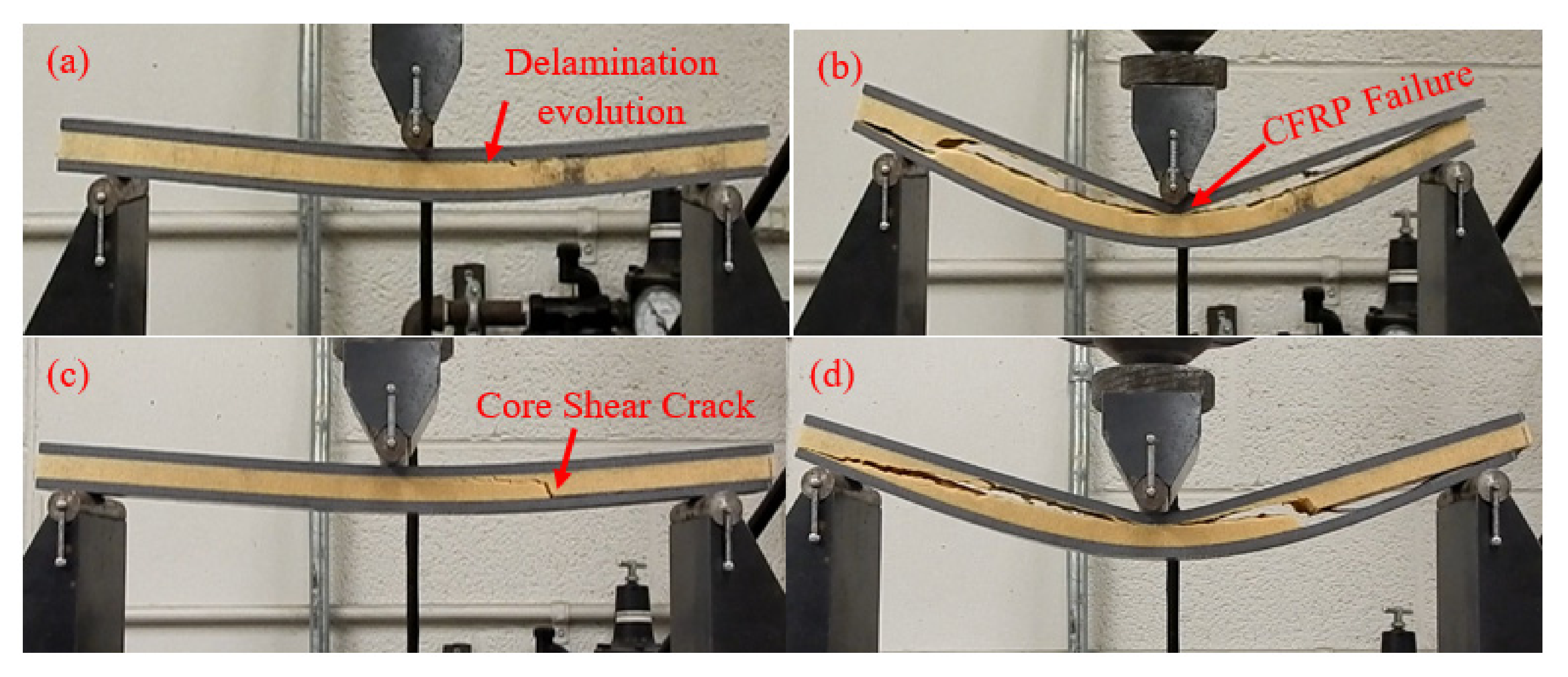
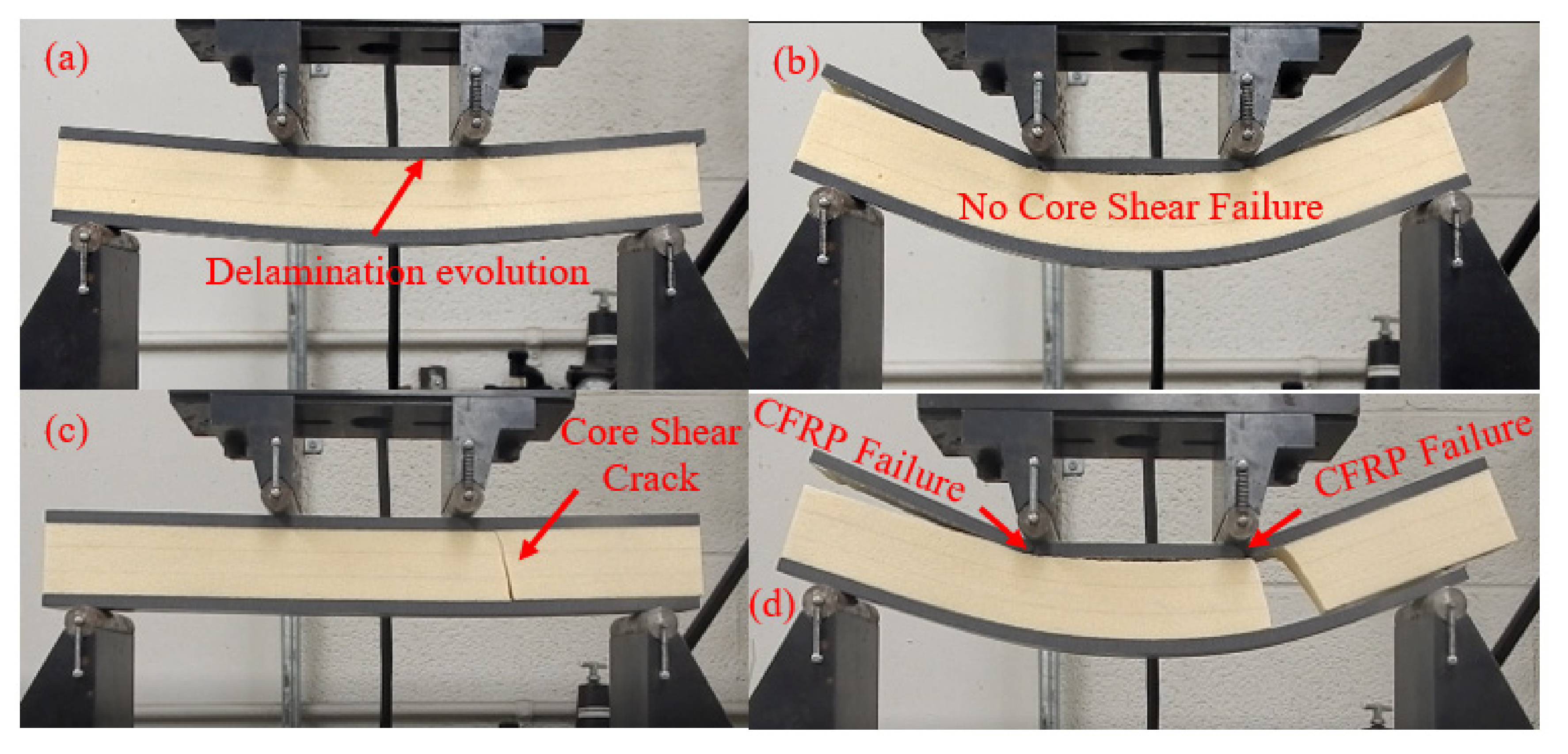

| Material | Material Parameter | Symbol | Value | Units |
|---|---|---|---|---|
| CFRP | Density | 1600 ± 5 | (kg/m3) | |
| Longitudinal Modulus | E11 | 81.2 ± 0.5 | (GPa) | |
| Transverse Modulus | E22 | 82.0 ± 0.7 | ||
| In-Plane Poisson’s Ratio | ν21 | 0.056 ± 0.002 | ||
| Shear Modulus in 1–2 Plane | G12 | 5.30 ± 0.06 | (GPa) | |
| Shear Modulus in 2–3 Plane | G23 | 3.30 ± 0.4 | ||
| Longitudinal Compressive Strength | Xc | 715 ± 20 | (MPa) | |
| Transverse Compressive Strength | Yc | 715 ± 15 | ||
| Longitudinal Tensile Strength | Xt | 828 ± 10 | ||
| Transverse Tensile Strength | Yt | 828 ± 10 | ||
| In-Plane Shear Strength | Sc | 104 ± 5 |
| Property Nomenclature /Units | Symbolic Representation and Values | |
|---|---|---|
| Density (kg/m3) | 248 ± 5 | |
| Tensile modulus (MPa) | Parallel to Rise Ext 171.43 ± 3 | Perpendicular to Rise Eyt 171.43 ± 5 |
| Compressive modulus (MPa) | Exc 118 ± 2 | Eyc 118.69 ± 5 |
| Shear modulus (MPa) | Gxz 57.81 ± 1 | Gxy 47.98 ± 1.7 |
| Poisson’s ratio | νxy 0.30 ± 0.02 | νxz 0.31 ± 0.035 |
| Tensile strength (MPa) | Xt 3.82 ± 0.2 | Yt 3.82 ± 0.1 |
| Shear strength (MPa) | Sxz 2.01 ± 0.5 | Sxy 1.80 ± 0.2 |
| Serial.No. | Core Thickness 9 mm | Core Thickness 29 mm | ||
|---|---|---|---|---|
| Peak Force (N) | Maximum. Displacement (mm) | Peak Force (N) | Maximum. Displacement (mm) | |
| 1 2 3 4 5 | 2750 2735 2700 2725 2712 | 35 38 39 36 38 | 5750 5740 5738 5745 5747 | 20 19 19.5 21 18.7 |
Publisher’s Note: MDPI stays neutral with regard to jurisdictional claims in published maps and institutional affiliations. |
© 2020 by the authors. Licensee MDPI, Basel, Switzerland. This article is an open access article distributed under the terms and conditions of the Creative Commons Attribution (CC BY) license (http://creativecommons.org/licenses/by/4.0/).
Share and Cite
Dhaliwal, G.S.; Newaz, G.M. Flexural Response of Degraded Polyurethane Foam Core Sandwich Beam with Initial Crack between Facesheet and Core. Materials 2020, 13, 5399. https://doi.org/10.3390/ma13235399
Dhaliwal GS, Newaz GM. Flexural Response of Degraded Polyurethane Foam Core Sandwich Beam with Initial Crack between Facesheet and Core. Materials. 2020; 13(23):5399. https://doi.org/10.3390/ma13235399
Chicago/Turabian StyleDhaliwal, Gurpinder Singh, and Golam M. Newaz. 2020. "Flexural Response of Degraded Polyurethane Foam Core Sandwich Beam with Initial Crack between Facesheet and Core" Materials 13, no. 23: 5399. https://doi.org/10.3390/ma13235399
APA StyleDhaliwal, G. S., & Newaz, G. M. (2020). Flexural Response of Degraded Polyurethane Foam Core Sandwich Beam with Initial Crack between Facesheet and Core. Materials, 13(23), 5399. https://doi.org/10.3390/ma13235399




